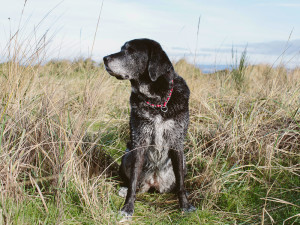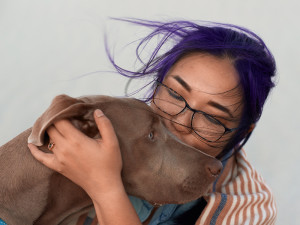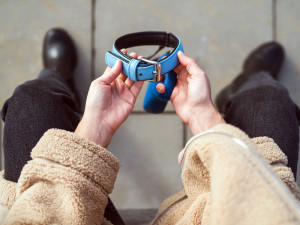Why People Say Pets Cross the “Rainbow Bridge” When They Die—And How It Helps
It’s become part of the pet-parent vernacular as a source of comfort.
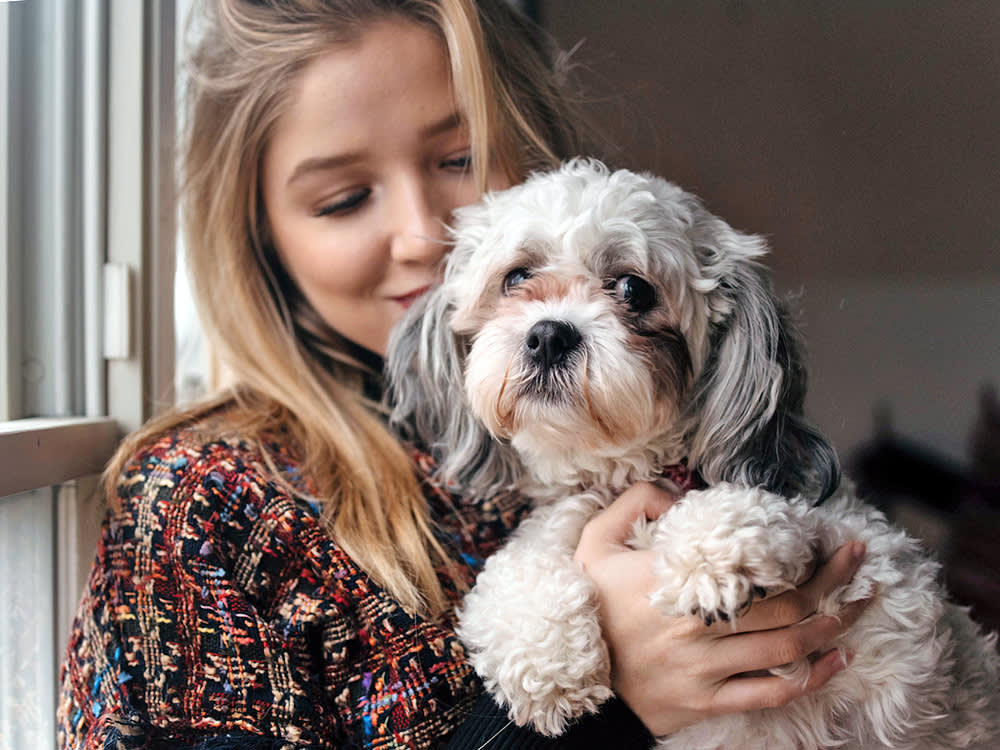
Share Article
I think about my dog Georgie’s mortality at least once a month. I don’t really have any reason for my anticipatory griefopens in a new tab. She’s a small Cattle Dog mix only seven years old, and most people assume she’s a puppy because she has a face that would make the cast of The Substance jealous. Plus, her boundless energy matches that of the Golden Retrievers puppies we often see sprinting down the beach. But when I have to take her for her annual appointment, and they use phrases like “middle-aged,” I have a crisis. Hell, I go to pieces when someone else’s dog is aging, sick, or dies. Selling Sunset star Crishell Stause’s pup, Gracie, passed away last week, and I was a wreck when I saw her Instagram postopens in a new tab.
I’ve only ever had to say goodbye to one family pet, a Miniature Poodle named Cinnamon. By the time she died, she‘d lost all her teeth and my dad had been pre-chewing her food for her, momma-bird style. Meanwhile, my mom had commissioned an urn in Cinnamon’s likeness, so things had gotten really, uh, weird at home. I was devastated, but at least she didn’t have to put up with my parents’ concerning behavior anymore.
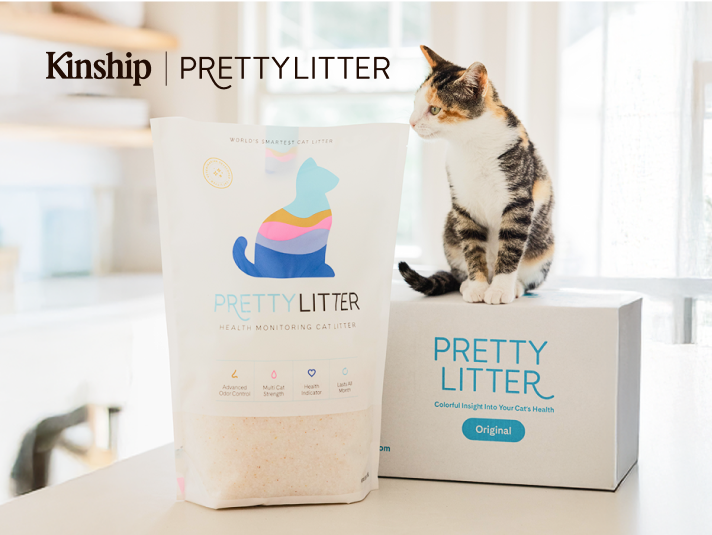
Save on the litter with color-changing tech that helps you better care for your cat.
Georgie is different, though. She’s the first dog I got in adulthood. She’s my baby. She’s seen me and my spouse through three moves, our wedding, an entire pandemic, ongoing fertility disappointments, and a news cycle that gives us daily jump scares. So, the idea of losing her is unbearable. It is made somewhat easier, though, by a concept in which many of my fellow pet parents take comfort: the Rainbow Bridge. Instead of saying a pet has died, modern pet parents often post on social media that their dog or cat “crossed the Rainbow Bridge.”
Karen London, an animal behaviorist and dog trainer, tells me that she loves the idea that a pet makes a journey over a metaphorical bridge, where they will wait for us until we cross over one day, too: “The Rainbow Bridge is a healing idea that I have seen help so many friends and clients when they have had to say goodbye to their dogs. The image of dogs anticipating their next hello with us, happy in a beautiful spot and waiting along with other dogs who have also left, until this joyous reunion occurs, is a source of comfort and even joy despite the depths of grief that accompany losing a dog.”
It’s safe to assume that no one reading this thinks there is actually a multicolored bridge in the sky with a pot of gold and Judy Garland and Toto waiting at the end of it. So, what does that idea mean, exactly, and where did it come from?
What’s the story behind the Rainbow Bridge?
As someone who had euphemisms trained out of her in journalism school, they always seem too saccharine for me. But when Cinnamon died, I found it was easier to say that she’d crossed the metaphorical bridge than telling people she’d “died.” I assume it’ll be the same way when my current dogs move on (see? I can’t even say it).
In 1959, a 19-year-old Scottish woman named Edna Clyne felt the same way when her first pup, Major, died. “He was a very special dog,” she recalled to art historian and author Paul Koudounaris for the site The Order of the Good Deathopens in a new tab. “Sometimes, I would just sit and talk to him, and I felt that he could understand every word I said.”
While she was grieving, she wrote a poem called “The Rainbow Bridge.”opens in a new tab It begins: “Just this side of Heaven is a place called The Rainbow Bridge. When each animal dies they arrive at The Rainbow Bridge. There are
meadows and hills for all of our special friends so they can run and play together.” The poem also says that “all the animals who had been ill and old are restored to health and vigor” and “the animals are happy and content,” except they miss their pet parents. Thankfully, the poem, concludes, your pet will wait for you when it is your turn to cross the bridge, and you will be reunited: “You have been spotted, and when you and your special friends finally meet, you cling together in joyous reunion, never to be parted again ... Then you cross the Rainbow Bridge together.”
As Koudounaris details, Clyne printed her words and handed them out to friends to comfort them and remind them that they will see their beloved pets again once they pass on, too. After that, the poem has been circulated across the world countless times over the years. You might receive it on a sheet of paper at your vet’s office after they’ve put your beloved cat or dog to sleep. Or you may see excerpts of it on gravestones at pet cemeteriesopens in a new tab.
But if “The Rainbow Bridge” was written in Scotland 66 years ago, long before Instagram grids, how did it make its way into popular culture? Well, kids, before there was Dear Prudence on Slate or Ask Polly on The Cut, there was Dear Abby, a syndicated advice column written by a mother-and-daughter team, Pauline (whose pen name was Abigail Van Buren) and Jeanne Phillips. In 1994, a Dear Abby reader going by “An Old Softy” shared the Rainbow Bridge poem with the columnist, who admitted to crying over it and responded, “I’m sure that many readers will be as moved as I when I read it.”
At the time Dear Abby published this particular column, no one knew who had written the “The Rainbow Bridge.” But in 2023, Koudounaris confirmed that Clyneopens in a new tab (whose married name is Clyne-Rekhy) is the person behind it. The woman, who was 82 at the time, told National Geographic that she had no idea her poem had reached so many people. “I’m absolutely stunned,” she said. “I’m still in a state of shock.”
How does the concept of the Rainbow Bridge help pet parents grieve?
To get a better understanding of why, as pet parents, we cling to euphemistic comforts like this when our dogs and cats die, I spoke to someone who spends a lot of time thinking about this specific kind of grief. E.B. Bartels wroteopens in a new tab a book opens in a new tabcalled Good Grief: On Loving Pets, Here and Hereafter for which she spoke to many pet parents about the death of their animals.
“Even people who I thought might be atheists or don’t seem very woo-woo or spiritual would bring up the Rainbow Bridge and seemed very moved by this idea that their pets are waiting for them somewhere,” she says. “I really love the idea that my pets are waiting for me, and I’ll be reunited with them like I would any other loved one.”
Bartels, whose dog Seymour died last year, notes that some people may feel shame around the idea that they may be feeling immense sadness over an animal, especially if they or someone they know have lost a human family member. But, she reasons, pets are members of our family, too, and “anybody who spends a lot of time around animals knows they have their own personalities. They have their own souls and spirits, and so it makes sense to me that they would also be in a place like that [in the] beyond.”
Why is pet grief so hard?
In my own life, I am somehow fine to say that a human in my life died. It doesn’t mean I don’t feel sad that this person is gone, but I don’t have to reach for any euphemisms when speaking about it. Maybe it’s because I lost family members and friends at a young age. I’ve had to become somewhat comfortable with the knowledge that people will leave me, even if I will miss them terribly. But my dogs? Forget it. I can’t bear the thought. Why is this?
Bartels tells me that I am in good company. She says that many people she spoke with for her book admitted to being “so much more upset when their dog or cat died than when their own parent died.” She says that she thinks one well-known factor with pets comes into play here: unconditional love. Our pets are our number-one allies; they love us no matter what, and humans are... well, more complex than that.
“When a person dies, you can have all kinds of baggage with someone,” she says. “My grandmother passed away last January, and we had a complicated relationship. She was one of my favorite people, but we had fights all the time. People don't say that about their pets usually. It’s just, like, this very pure love. So, when people lose that, it hits very differently.”
Bartels says that after interviewing psychologists and other grief experts for her book, she learned that “grief is grief,” no matter whom or what someone may be mourning. “If you’re really upset about your dog, and you’re grieving your dog, it’s probably reminding you of when your grandmother died or your friend died or your childhood fish died.” In other words, your love for your pet isn’t complicated but the process of mourning them might be.
Find your Rainbow Bridge, whatever that is (or visit the real one).
And what better way to soothe a complicated wound than with a little magical salve, like the Rainbow Bridge or a church covered in photos of dogs? Bartels, who is still feeling the pain of the loss of Seymour, tells me that she, her husband, and her baby are making a trip soon to Dog Mountainopens in a new tab, a spot in St. Johnsbury, Vermont, where there is a chapel full of tributes to people’s departed pups. She plans to add her own memorial to Seymour there. She wonders, too, if there is a real Rainbow Bridge somewhere, kind of like Dog Mountain, where people can go to honor their pets who have crossed over. Yes, I tell her, in fact, there is.
It’s in Torrington, Connecticut, and it’s a painted Rainbow Bridgeopens in a new tab embraced by the local community where people can leave their tributes to their pets. So, I guess we should stop calling the bridge an idea, because it does exist. It exists in the form of this very real structure in Connecticut, or in any tangible memorial we choose to make for the ones we miss, like a simple clay imprint of their paw print that we can keep forever or this hidden beach memorial gardenopens in a new tab in San Diego. Whatever it is that links us back to the dogs and cats we miss and will hopefully see again one day — somehow, somewhere.
Bartels puts it best: “We don’t know what happens when we die, and people have all kinds of beliefs of what does or doesn’t happen ... having a story like the Rainbow Bridge for pets makes sense to me because if you love another being regardless of what their species is, you miss them when they die, and you wonder where they are now and you hope their spirit is carrying on in some capacity.”

Hilary Weaver
Hilary Weaver is the senior editor at Kinship. She has previously been an editor at The Spruce Pets, ELLE, and The Cut. She was a staff writer at Vanity Fair from 2016 to 2019, and her work has been featured in Esquire, Refinery 29, BuzzFeed, Parade, and more. She lives with her herding pups, Georgie and Charlie.
Related articles
![Woman comforting her friend who has lost a pet.]() opens in a new tab
opens in a new tab10 Ways to Support a Friend Who Is Grieving a Pet
Not everyone understands how hard it is to lose a pet. You can be the person who does.
![Portrait Of Large, Senior, Mixed Breed Dog On Beach]() opens in a new tab
opens in a new tabHow to Grieve a Pet
For National Pet Memorial Day — Sept. 12th — we asked 5 grief experts how to cope with feelings of guilt after we lose a pet.
![Boy petting his old dog at home on the bed.]() opens in a new tab
opens in a new tabWhat Do You Tell Your Kids When Your Family Pet Dies?
Fluffy didn’t go to a farm to chase rabbits, so maybe don’t say she did.
![Woman with purple hair kissing the face of her chocolate brown hound dog]() opens in a new tab
opens in a new tab8 Comforting Thoughts to Help You Through the Death of Your Pet
There’s no guidebook to grief and loss — but these kind words will help.
![a person holding a dog collar]() opens in a new tab
opens in a new tabIs Pet Bereavement Leave in Our Future?
More companies are considering how they can support grieving pet parents.




